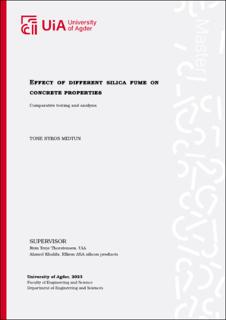| dc.description.abstract | Concrete, as the world’s most widely used construction material, contributes significantly to climate change due to emissions generated during cement production. The industry has set ambitious goals to achieve carbon-neutral concrete production by 2050. Microsilica is a by-product of the silicon and ferrosilicon
alloy industries and processes, and the unique properties of the material may have an influence on the concrete.
The objective of this study is to explore the impact of incorporating 10 different types of microsilica on the properties and characteristics of concrete. Process development and a preliminary study have been conducted as preparative work before investigating the effect of microsilica on concrete properties. The influence of microsilica on fresh mortar properties, strength development and durability has been investigated by execution of flow tests, temperature logging, total heat value calculation, standard mechanical strength tests, pozzolanic activity index, chloride ion migration tests, and microscopic imaging.
As a result of the testing and comparative analysis, several observations about how microsilica influences concrete properties have been obtained. A common denominator in the observations for all tests was that the densification of the microsilica allegedly does not influence the properties of concrete. The BET specific surface area of the microsilica influence both the flowability of the mortar as well as the pozzolanic activity index of the samples after 28 days of curing. Low BET SA (m2/g) gave high flowability and an increase in PAI was observed for mortars containing microsilica with high BET SA (m2/g). The pozzolanic activity index of the mortars also showed an increase as the content of silicon dioxide in the microsilica increased. When assessing how the mortars were influenced by the pH of the microsilica samples, complete setting time was investigated and it was concluded that there was no correlation between pH of microsilica and the complete setting time. However, there was a minor correlation between the complete setting time of the mortars and the alkali content of the microsilica samples, where low alkali content gave an early complete set. No correlation was observed when investigating the influence of moisture in the microsilica samples on the flowability of the mortars. | |
